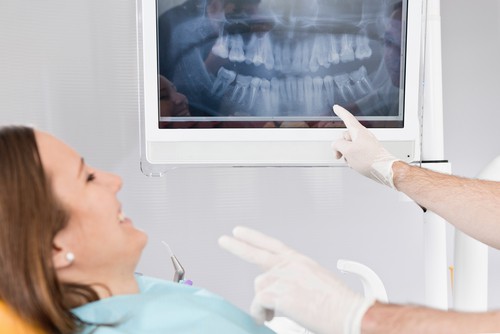
It’s very rare that a day goes by at our Strongsville dental office where we don’t rely on the power of x-rays to help us plan for or even complete a case. We’re able to get a good look at everything from your teeth and gums to your jaw bone and bite health. We can see things that aren’t always visible at first glance.
With the advancements in dental technology, there are many different types of x-rays available on both traditional film and digitally. Most dental offices have made the switch to digital x-rays, but it’s important to note that today’s dental x-rays are very safe and give off very little stray radiation. Dental x-rays are advanced thanks to changes in dentistry over the years relying on using:
When it comes to dental x-rays, there are two types of ways your Strongsville dentist might go about getting the right images to help your smile. Besides having the option of having photos taken on traditional film or images that are stored digitally, dentists can choose either an intraoral or extraoral x-ray.
Intraoral means inside your mouth and extraoral means outside the mouth. Intraoral x-rays are the most common type of dental x-ray and provide an extremely high level of detail to help us diagnose cavities, examine your tooth roots, look over your bony areas, check the status of developing teeth, or monitor ones that have yet to erupt.
Extraoral x-rays are usually relied on to help dentists and orthodontists focus on the bones in your head, mainly your upper and lower jaw. We can see the bigger picture of what’s going on from your head to neck and how it’s all connected to your oral health and growth.
If you combine both intraoral and extraoral radiographs, there are eight different kinds of x-rays that dentists can use to treat patients. Some of the most common ones include:
1) Panoramic X-Rays – Gives the dentist a full view of your nasal area, jaws, teeth, joints, and sinuses. Orthodontists love doing these x-rays before treatment, so they know how things are growing and coming together in younger patients.
2) Periapical X-Rays – Focusing on one tooth, we can see it in its entirety from crown to bone.
3) Bitewing X-Rays – These images are taken when we need a better look at your back teeth or molars. It helps in diagnosing wisdom teeth problems and shows the dentist how your teeth fit together.
4) Occlusal X-Rays – This is helpful for younger patients because these images give us a clear view of what’s going on underneath the gum line and how teeth are placed. We get a perfect view of both your upper and lower arch. We can also see if you have extra teeth that never broke through your gums.
If you’re interested in learning more about x-rays or want to know if you’re due for a set or two, please call your dentist in Strongsville. (If you’re looking for a new dentist and need some x-rays, we’re happy to help with that too!)